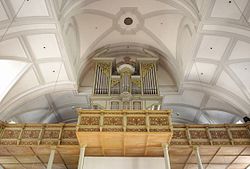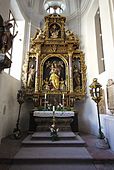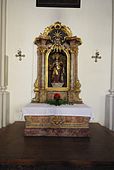St. Andreas (Berchtesgaden)
The parish church of St. Andreas was built by the citizens of the Berchtesgaden market in 1397. Since 1803 it has only been called the parish church in its name , without having its function. It is now a branch church of the Roman Catholic parish of St. Andreas in Berchtesgaden in Bavaria and belongs to the Archdiocese of Munich and Freising .
Buildings and history
According to A. helmet already in 1358 to the site of the present church provost James I of Vansdorf have built (1362-1368) a chapel leave that would have been a little later destroyed.
Erected in 1397 by the citizens of the market town of Berchtesgaden, there are “underground” medieval and early modern findings and finds from its predecessor buildings at the now listed parish church of St. Andreas , including a cemetery that was abandoned in 1811.
The single-nave Romanesque hall building dates from the second half of the 13th century, the current shape of which is the result of renovations starting in 1480. According to A. Helm, however, it was not until 1500 that the imperial prelate and provost Balthasar Hirschauer (1496–1508) made structural changes. This is evidenced by the Hirschauer coat of arms affixed above the tower portal, as, according to the Bavarian State Office for Monument Preservation, the elevation of the west-facing tower is set for the year 1500. Under Provost Gregor Rainer , the sacristy was added in 1510, the door of which in turn shows his coat of arms.
At the end of the 17th century (1693–1701) the interior of the church was expanded and redesigned in Baroque style and a bell dome was added to the tower. A. Helm says that the church was "demolished in 1698 (..) and the current one built in 1699 in the Baroque style".
After the abolition of the prince-provost of Berchtesgaden and its canons' monastery in 1803, their collegiate church of St. Peter and John the Baptist became the parish church and it was then repeatedly discussed whether to tear down the "old" parish church of St. Andrew or, as planned in 1922, to incorporate it To convert clubhouse. According to A. Helm, on the other hand, after a fire in the previously wooden tower in 1842, it was "provided with masonry" in 1847 and "the marble pillars were placed on the outside of the hall".
The church building, still known as the “parish church”, is only used for services on weekdays. Its patron saint, St. Andreas , continues to denote the parish in the Berchtesgaden market - on the other hand, the actual parish church, in which all high offices and festive services are celebrated on Christian holidays, is still called the “collegiate church”.
Furnishing
Bells, tower clock
The oldest bell in the church was cast in 1537 and the tower clock dates from 1700.
Altars
The high altar as well as the two smaller side altars facing each other on the wall sides date from the years 1703–1705 (According to A. Helm: 1708) and were created by local artists. The two older side altars directly on the side of the high altar (left: Marienaltar, originally probably Andreas Altar, right: Anna selbdritt ) date from the first half of the 17th century. In the years 1740–1742 Johannes Zick created five altarpieces for the church.
organ
Main organ

The organ was built in 1993 by the organ building company Johannes Klais (Bonn). The instrument has 21 stops on two manuals and a pedal . The second manual is doubly swellable: on the one hand to the back, to accompany choirs, and with a second pedal to the front. The playing and stop actions are mechanical.
Disposition of the organ:
|
|
|
||||||||||||||||||||||||||||||||||||||||||||||||||||||||||||||||||||||||||||||||||||||||||
- Coupling : II / I, I / P, II / P
Choir organ
A choir organ stood on an oratorio in the presbytery of St. Andrew's Church, which was demolished in the 1950s and 1960s ; the case that was cleared back then now stands carelessly next to the main organ on the music gallery. It is most likely the instrument that Paul Rotenburger created in 1660 and that had 5 registers and a tremulant. The "corner solution" of the organ case is reminiscent of that of the old crossing organs in Salzburg Cathedral, the first two of which were made in 1628 by Paul Rotenburger's father, Leopold Rotenburger .
Individual evidence
- ↑ a b c d e f g h Hellmut Schöner (ed.), A. Helm : The Berchtesgadener Land in the course of time. Reprint from 1929. Association for local history d. Berchtesgadener Landes. Verlag Berchtesgadener Anzeiger and Karl M. Lipp Verlag, Munich 1973, ISBN 3-87490-528-4 , pp. 240, 241.
- ↑ Since, according to the current sources, however, Peter I. Pfäffinger was provost of the monastery in 1358 and nothing is known of such a foundation on the part of Jakob I von Vansdorf before he took office, there is an error either in the year or in the name of the builder of the chapel.
- ↑ a b c Bavarian State Office for the Preservation of Monuments: Specialist information former. Stiftspfarrkirche St. Andreas. Retrieved April 17, 2009 .
- ↑ a b c d e stiftskirche-berchtesgaden.de On the building and history as well as a photo with an interior view of the parish church of St. Andreas
- ↑ stiftskirche-berchtesgaden.de on the conversion of the collegiate church as a parish church from 1803
- ↑ stiftskirche-berchtesgaden.de Among other things, on the function of the collegiate church.
- ↑ Information on the organ of St. Andreas
- ↑ Georg Brenninger: Organs in Old Bavaria . Munich 1978, p. 183.
Web links
Coordinates: 47 ° 38 '3.3 " N , 13 ° 0' 14.9" E








